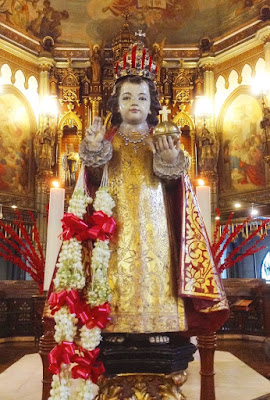Santo Niño de Praga of Manila - The Miraculous King of Mendiola, Manila
 |
| Santo Niño de Praga of Manila |
In the famed Abbey of Our Lady of Montserrat, aside from the Virgin of Montserrat, there is another venerated image that also enjoy much devotion and veneration by the Benedictine monks, students and alumni of San Besa University and its sister schools and the faithful of Mendiola, Manila - the miraculous Santo Niño de Praga of Manila.
The image of Santo Niño de Praga became one of the distict devotions within Manila's University belt and his devotees would flock the abbey to ask for his miraculous intercession.
The image
The venerable image of Santo Niño de Praga de Manila is wooden image of the Child Jesus done in de tallado style. The Niño's caoe and robe are painted in estofado style that gives an illusion that the image was wearing a set of embroidered vestment.
The Prague Child of Manila was patterned from that of the original image in Prague in Czech Republic: The Child Jesus stands upright, his right hand is in gesture of blessing while his left hand, holds a globus cruciger, wears a set of crown and jewels and faces the beholder. The differences between the Prague Child of Manila and Prague are the hair of the Manila image has dark hair and his vestments has a narrow opening while the original Prague Child of Czech Republic has blonde hair and his vestments had a wide opening.
The Prague Child of Manila was patterned from that of the original image in Prague in Czech Republic: The Child Jesus stands upright, his right hand is in gesture of blessing while his left hand, holds a globus cruciger, wears a set of crown and jewels and faces the beholder. The differences between the Prague Child of Manila and Prague are the hair of the Manila image has dark hair and his vestments has a narrow opening while the original Prague Child of Czech Republic has blonde hair and his vestments had a wide opening.
The devotion to Santo Niño de Praga was born out of devotion of the students of Colegio de San Beda (now a University). On December 13, 1903, the Benedictine Community in Manila agreed to establish the Confraternity of the Infant Jesus for the students of the Colegio de San Beda. The following day the students presented to the Rector a formal petition for the establishment of a Confraternity.
In January 1904, the hymn O Niño Dios was composed by Fr. Jaime Bofill, OSB, who taught music at the Colegio and became a staple in the Colegio's music and can still be heard at present. On January 17, 1904, the monks and students celebrated the feast of the Sto. Niño at San Beda for the first time. Since no statue was available, they used a framed picture of the Holy Child.
On November 4, 1904, the Community installed a wooden image of the Sto.Niño de Praga at the Benedictine Chapel in Tanduay. The image was carved by Maximo Vicente, a known sculptor of religious images patterned after an image venerated in the Church of Salesian Sisters in Barcelona, Spain.
On December 28, 1904, the Archbishop of Manila, Archbishop Jeremias Harty, gave permission for the establishment of the Confraternity of Sto. Niño de Praga. The Colegio held the first procession of the Sto. Niño with the image made by Maximo Vicente on January 20, 1905. Its route was from the Colegio de San Beda in Arlegui to the house of the Benedictine Community on Balmes Street.
 |
| Santo Niño de Praga de Manila |
The devotion would later spread in different branches of San Beda University, notably in San Beda College in Alabang, Muntinlupa City where a replica of Santo Niño de Praga is venerated and celebrate His feast every third Sunday of January.
The devotion at present
The Feast of the Santo Niño de Praga is celebrated every last Sunday of January preceded with a novena and on his feast day, the Frolics will take place where the monks, students, alumni and devotees enjoy the festivities with so much merriment that adds the festive mood. On his feast day, the image is brought down to his altar for public veneration and by afternoon, the image would be placed in his templete for procession flanked with the image of Our Lady of Montserrat and Benedictine saitns. Once the procession ended, the image will be brought to the university grounds for fiesta mass.
The devotion to Santo Niño de Praga continues to be strong up to this day. Miracles were reported through his help, notably of a lady with a fractured bone was cured without operation. Devotees and pilgrims would always enter the abbey with the beautiful face of the Santo Niño de Praga welcoming them and ready to hear his beholder's supplications.
Before we conclude this blogpost dedicated to the miraculous Santo Niño de Praga, here is the hymn that students and alumni of San Beda sings in honor of their beloved King:
O Niño Dios
O Niño dios de praga rey clemente
el viador sosten
solo de ti de gracia rica fuente
dimana dimana todo bien
solo de ti de gracia rica fuente
solo de ti de gracia rica fuente
dimana dimana todo bien
Niño Hesus tao at dios na tunay
sa landas ay tanglaw
tanging bukal ng pag asa at buhay
biyaya sa lupa'y isilay
tanging bukal ng pag asa at buhay
tanging bukal ng pag asa at buhay
biyaya sa lupa'y isilay
References:
Florendo, Abe, "Santo Niño: the Holy Child devotion in the Philippines", Congregacion del Santisimo Nombre del Niño Jesus, Manila, 2001.
Manalastas, Anselm, OSB, "A Short History of the Devotion to the Sto. Niño de
Praga in San Beda College (Manila and Alabang)", Retrieved from https://www.sanbeda-alabang.edu.ph/bede/images/images/2014/SBCA/a%20short%20history%20of%20the%20devotion%20to%20the%20sto%20webpost.pdf on February 3, 2020.






Comments
Post a Comment